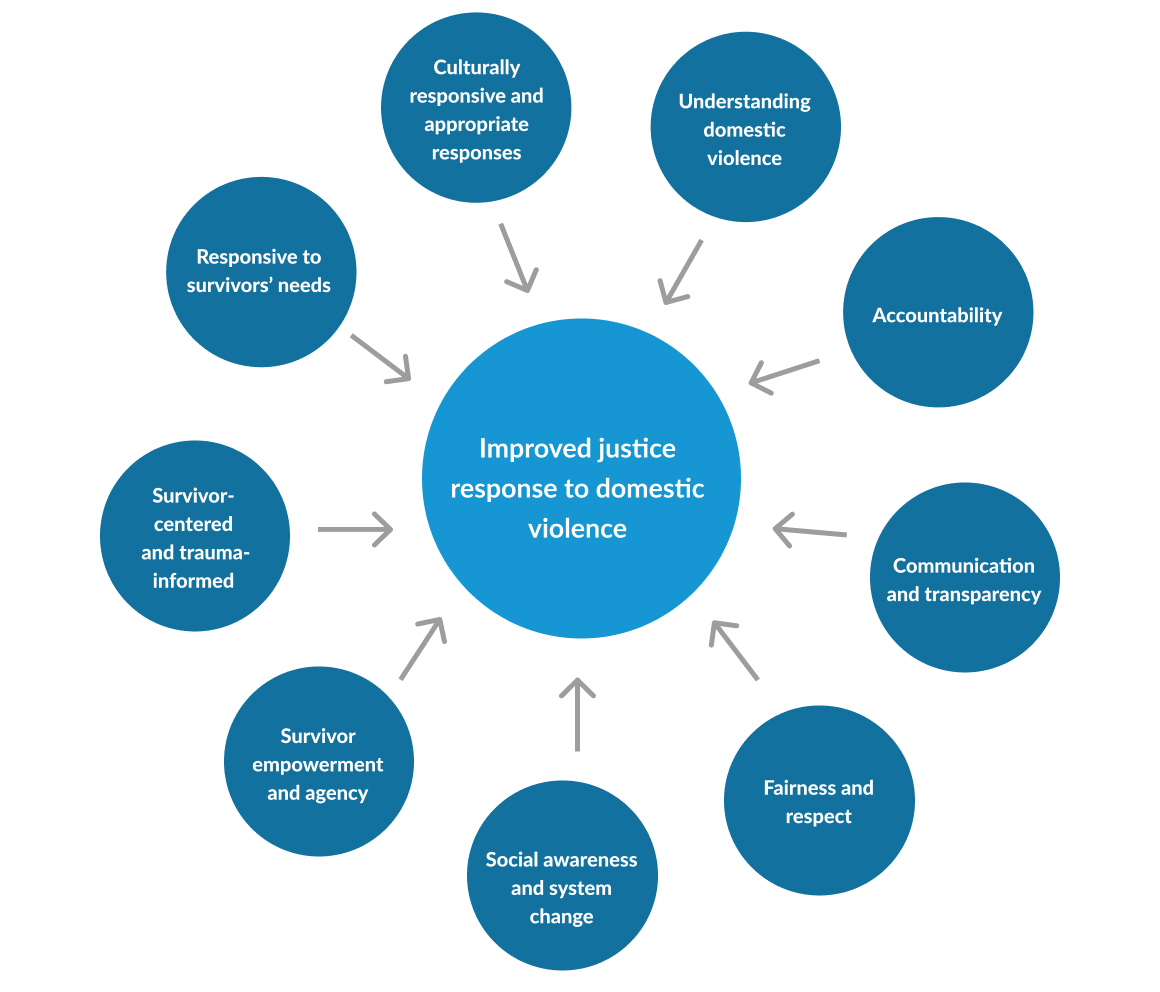
Domestic violence affects millions of Americans (PDF) and causes serious consequences for survivors, their families, and communities. Yet the systems designed to provide safety and justice—from traditional legal processes to restorative justice programs, community-based support, and victim services—often fall short.
This year’s Domestic Violence Awareness Month theme, "Heal, Hold, and Center," gives us a chance to explore how policy can support domestic violence survivors on their healing journey, hold space for their voices and needs, and ensure survivors remain at the center of systems’ responses to domestic violence.
In a recent study, we explored how domestic violence survivors from diverse backgrounds felt about justice, accountability, and safety, and whether these goals were achieved through the legal system, restorative justice programs, and community-based support. We then collaborated with survivors and practitioners to develop nine guiding principles aimed at shaping justice policy responses to domestic violence.

Source: Malore Dusenberry and Susan Nembhard.
Here’s how policymakers and leaders can adopt these principles to help survivors heal, hold space for them, and keep marginalized survivors at the center of policies and practices intended to serve them.
Promote survivors’ healing
Of the nine guiding principles for domestic violence response policy and practice, three stand out for their opportunity to promote survivor healing.
The first is responsiveness to survivors’needs. This requires that domestic violence responses be tailored to each survivor’s unique experiences and needs. Policies can ensure survivors receive safety planning as well as screenings and referrals for financial and mental health resources throughout any justice intervention. This also acknowledges that no one agency or organization alone can meet all of a survivor’s needs, and that survivors would benefit if policymakers support greater collaboration between these groups.
Understanding domestic violence itself means knowing what types of abuse survivors experience, how their nuanced reactions to trauma affect their engagement with practitioners, and how their justice preferences are shaped by complex relationships with the person who harmed them. Survivors are best able to find justice and healing when response systems are adequately trained to recognize the complexities that come with domestic violence.
When survivors have a say in how accountability is pursued, they can regain a sense of control necessary for healing. Law enforcement, prosecutors, and judges should have guidelines in place for how to adapt their responses based on how the survivor defines accountability. For some, that will mean traditional legal system engagement, but others may seek alternative forms of justice.
Communities can invest in intervention programs for people who cause harm that provide them with education, encourage them to acknowledge the damage they’ve caused, and offer them resources to help break the cycle of abuse. Restorative justice programs, which focus on repairing harm and fostering healing for both parties, are another powerful option.
Hold space for survivors’ voices and needs
Three of the guiding principles emphasize creating space for survivors through empowerment, communication, and respect.
Survivor empowerment and agency refers to survivors' rights to make their own decisions and have control throughout any justice-focused process. Empowering survivors requires more than just believing them when they speak out. It’s also about equipping them with the knowledge they need to make informed decisions.
One approach is to change legal system and community-based response policies to give survivors more time during the justice process to express their choices. In turn, legal system professionals and community-based program facilitators should have the flexibility to shape responses accordingly.
Communication and transparency involves sharing information with survivors clearly, frequently, and consistently throughout the justice process. This includes keeping them informed about the process and their options and rights.
In our recent study, many survivors were frustrated with the lack of information on the legal system and felt unprepared to make the numerous decisions they face on the road to recovery. Policies and practices thatassign staff to set expectations with and update survivors, make legal processes more transparent, and break down bureaucratic barriers could reduce isolation and increase support for survivors.
Fairness and respect in justice responses means ensuring that the agencies responsible for justice in domestic violence cases strive for fair outcomes, that individual practitioners treat survivors equitably, and that survivors have equal access to services and legal systems.
Providing free or affordable legal representation is a critical step toward ensuring survivors can navigate the system without being held back by finances. Scheduling court dates and meetings around survivors’ work and transportation needs can also make a significant difference in survivors’ engagement. Additionally, some survivors face language barriers, making qualified interpreters essential for fair accessibility.
Centering survivors in justice responses
The final three guiding principles help ensure survivors’ needs and perspectives remain the focus of policies and practices intended to serve them.
Being survivor-centered and trauma-informed means protecting survivors’ privacy and avoiding actions that could cause further harm while providing services or pursuing justice. It also means treating survivors as the experts on their own lives and empowering them to define justice, safety, and accountability for themselves.
Listening to survivors ensures their lived experiences and insights shape domestic violence policies and programs. Policymakers and practitioners can do this by including survivors as partners in efforts to design or reform responses to domestic violence and paying them for their time and expertise.
Providing culturally responsive and appropriate care acknowledges that survivors come from diverse backgrounds, with different identities and experiences. Recognizing this and the challenges many communities face is essential for creating policies that are more effective and responsive to those who are most affected.
Leaders can review services and responses for institutional barriers and cultural relevance and enact changes to make information and programs easier to access. This should involve providing language-appropriate support and training staff to work with survivors of all backgrounds.
Social awareness and systems change involves educating policymakers, the media, and the public about how structural barriers affect whether survivors of differing backgrounds and income levels can access justice and healing. It also means investing in eliminating the social structures and forms of oppression that contribute to domestic violence and tracking community-level progress in reducing domestic violence.
Helping survivors thrive beyond Domestic Violence Awareness Month
Each person affected by domestic violence has their own unique needs for recovery, safety, and justice, and our systems must evolve to meet these diverse needs. Adopting these nine guiding principles for policy action is a crucial step toward creating a more responsive, supportive, and survivor-centered domestic violence response system and ensuring more survivors can access long-term well-being.
Let’s build a future where everyone, everywhere has the opportunity and power to thrive
Urban is more determined than ever to partner with changemakers to unlock opportunities that give people across the country a fair shot at reaching their fullest potential. Invest in Urban to power this type of work.